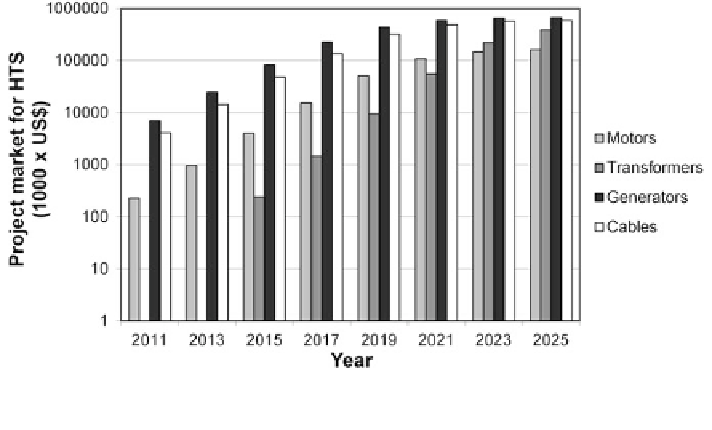Environmental Engineering Reference
In-Depth Information
Fig. 9.9 The market projection for high-temperature superconductor applications (data taken from
Mulholland et al. [
23
])
small helium coolers (k$) for refrigeration at 4.2 K (W) [
22
]. The calculation was
based on Eq. (
9.11
).
Our search for market analyses on superconducting applications led to rather old
reports. For instance, in the report by Mulholland et al. [
23
] the authors did an
analysis of future prices and markets for high-temperature superconductors (HTS).
Despite this being a rather old report from 2001, it is important to address the trends
of production as well as the costs associated with the applications of HTS. For the
rst, Fig.
9.9
shows a projection of the market for high-temperature superconductor
applications. For the second, the authors have stated that researchers will sub-
stantially increase the current carrying capacity of HTS wires, and by also taking
into account the rapid decrease of HTS wire costs with an increased length; this will
substantially reduce the investment costs by 2020.
9.3 Review of Cost Analyses for Magnetocaloric Energy
Conversion
Some of the earliest cost analyses on magnetic refrigeration were performed by
Russek and Zimm in 2006 [
24
], where they focused on the application of air
conditioners. They used a simple approach in which they de
c costs
of the magnetocaloric material and the permanent-magnet material per cooling
power of the device. Their study revealed that when using Gd or similar material at
a cost of 20 US$kg
−
1
, for an operating frequency of 10 Hz for the device, the costs
for such a material will be 1.5 US$(kWcooling)
−
1
. They estimated the cost of the
La(Fe
1-x
Si
x
)
13
material to be 8 US$kg
−
1
, which led to the speci
ned the speci
c cost of such a

Search WWH ::

Custom Search